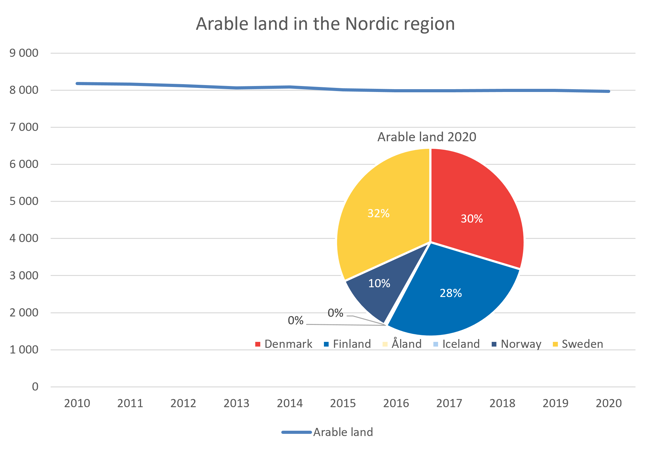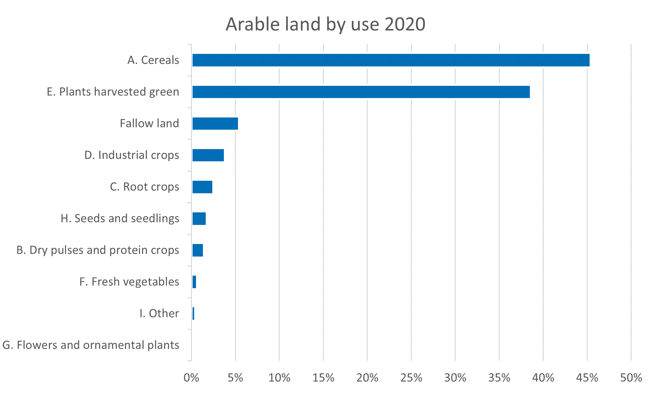Production of cereals and grass plants most common in the Nordics
In 2020 the Nordic countries combined, Greenland and Faroe Islands excluded, had just under 8 million hectares arable land, 8 percent of the total arable land in the EU. Over the past ten years the arable land in the region has decreased by 2 percent. Most of the arable land in the Nordic region is used to grow either Cereals to produce grain (including seed) or Plants harvested green. 5 percent of the arable land was fallow in 2020.
Agriculture is an important sector in the Nordic countries, both in terms of regional culture, employment and food supply. The latter has been accentuated in recent times, with the pandemic and the war in Ukraine has affected our possibilities of importing food. One thing that directly affects how much can be grown is the amount of arable land. Arable land is land worked (ploughed or tilled) regularly, generally under a system of crop rotation.
In 2020 the Nordic countries, Greenland and Faroe Islands excluded, had just under 8 million hectares arable land combined, 8 percent of the total arable land in the EU. The amount of arable land in the Nordic region has been quite stable over the past ten years, but a slow decrease can be seen. Compared with 2010, the 2020 figure is 2 percent smaller [1].

Source: Nordic Statistics Database, AGRI10: Arable land and permanent grassland by reporting country, area, crops and time
Three countries; Sweden, Denmark and Finland [2], have around 30 percent each of the combined arable land in 2020. Norway has 10 percent, while Iceland and Åland have less than 0.5 percent each. This distribution has been very stable over time.
Cereals to produce grain (including seed) and Plants harvested green are the two by far largest types of crops in the Nordic region. A total of 45 percent of all arable land in the region was used to grow Cereals and 39 percent to grow Plants harvested green in 2020.
These two main types of crops are the most common also when analysed by country. The share of arable land used for Cereals varied between 14 percent in Iceland and 58 percent in Denmark and for Plants harvested green between 22 percent in Denmark and 73 percent in Iceland.

Source: Nordic Statistics Database, AGRI10: Arable land and permanent grassland by reporting country, area, crops and time
When analysed by harvested production, in tonnes [4], it can be noted that the most common sub-type of Plants harvested green, in harvested production, is Temporary grasses and grazing (grass plants for grazing, hay or silage). For Åland, Iceland, Sweden and Finland this sub-type constitutes 90 percent or over of the total harvest production of Plants harvested green. In Denmark, Temporary grasses and grazing accounts for 60 percent of the harvest, while Green maize accounts for 33 percent. [3]
Cereals to produce grain (including seed) can be divided into eight sub-types of crops. Of these, three dominate in terms of harvested production. Wheat and spelt accounts for between 20 (Finland) and 54 percent (Sweden), Barley for between 25 (Sweden) and 100 percent (Iceland) and Oats for between 4 (Denmark) and 36 percent (Finland). Combined these three thus constitutes over 90 percent of all harvested Cereal in the five countries with available statistics on crop production from arable land (Denmark, Finland, Åland, Iceland and Sweden).
5 percent of the arable land in the Nordic region, or 0.4 million hectares, was Fallow during 2020, meaning it was not intended to produce a harvest for the duration of this year (it is either included in the crop rotation system or maintained in good agricultural and environmental condition, and might be worked or not). Almost half of this area was found in Finland, a third in Sweden and a fifth in Denmark, whilst the other countries had less than a half percent each.
[1] Data for Iceland is missing for 2010 and 2016. Since their arable land area is quite small, it does not affect the comparison between the years 2010 and 2020.
[2] The 2013-figure for arable land in Finland is under review. The value included here has been estimated as the reported arable land plus the reported fallow land.
[3] Norway is excluded from this part of the analysis as their report on harvested production by type of crop is not complete.
[4] Source: Nordic Statistics Database, AGRI11: Crop production from arable land by reporting country, crops and time.